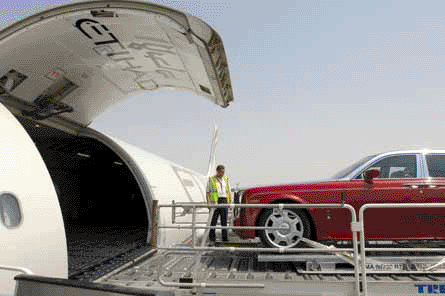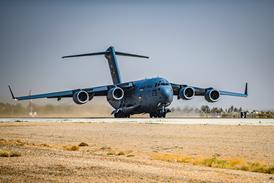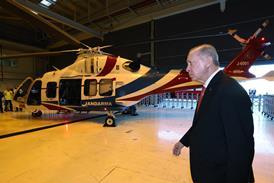Massive growth in air cargo is prompting Middle Eastern airlines to add dedicated freighters rather than just relying on belly capacity of passenger airliners. Mark Bursa reports.
Freight is big business in the Gulf. The region’s geographic location makes it an ideal natural hub for the increasing volume of cargo traffic flowing between Asia and Europe and North America. Transit freight accounts for 80%-90% of overall traffic through the region’s hubs.
And the volumes are growing. In 2006, the Middle East was again the fastest growing region for cargo traffic in terms of freight tonne kilometres (FTKs), recording full-year growth of 16.1%, according to IATA. And freight is expected to grow more strongly at Middle East airports than passenger traffic, rising 7.9% annually to 2010, according to Airports Council International (ACI) forecasts.

Now Middle Eastern airlines are adding extensive fleets of dedicated freighters to augment the enormous freight capacity offered by the bellyholds of their widebody passenger fleets. In the past 12 months, Emirates, Etihad and Qatar have all placed orders for dedicated widebody freighters, while Gulf Air is considering similar purchases.
Emirates SkyCargo has ordered 10 next-generation Boeing 747-8F freighters in a $3.3 billion deal, as well as eight Boeing 777Fs. The aircraft will be delivered from 2009, joining a mixed fleet of nine dedicated cargo widebodies: four Boeing 747-400Fs, two 747-200Fs and three Airbus A310Fs.
Last year, Emirates SkyCargo, which accounts for 21% of the airline's transport revenue, carried 1.2m tonnes of cargo, generating revenue of $1.5 billion. Despite Emirates’ huge commitment to the passenger A380 - it has 55 on order - the freight version is unlikely to figure in the fleet. “The 747F is a lot more flexible as it can be handled at virtually any airport,” says Ram Menen, Emirates divisional senior vice-president cargo.
The fact that the A380 will figure in a big way on the passenger side will influence the airline’s cargo capacity. “Right now 65% of our business comes from the bellyholds of the passenger fleet, but this is likely to fall to 45% as the A380 passenger aircraft has reduced belly cargo volume,” says Menen. “We are in a transition from freighters being supplemental to our belly capacity to them being the larger contributor to our cargo volume.”
Dubai’s central location is key to its success in both passenger and cargo markets, says Menen. “There are 5.8bn people within 8h flying of the emirate - that’s 5.8bn potential customers. Even though only 2% of them use our services, it’s a huge number. Two-thirds of the world’s population is east of Dubai.”
Competition for business in the region is intense. The region’s most recent arrival, Etihad Airways, has leveraged the strength of the international cargo market during its early years, with air freight contributing more than 25% of total revenues. Etihad has also moved into dedicated cargo operations, launching Etihad Crystal Cargo in September 2004. The division currently operates a fleet of two Airbus A300-600Fs and a leased MD-11F, serving ten destinations in Europe, India and China.
“When Etihad was formed, the decision was taken to have a freighter fleet well before we had absorbed the level of belly capacity that a mature airline would traditionally want to achieve before it added freighter capacity,” says executive vice-president Des Vertannes.
Etihad Crystal Cargo is growing rapidly, doubling its 2005 turnover of $98.5 million in 2005 to more than $200m in 2006. Flight International estimates that it carried around 160,000t of freight last year, and Vertannes expects the cargo arm to generate “close to $300 million in revenue this year”.
At the 2007 Paris Air Show, Etihad ordered three Airbus A330-200F freighters with a 69-tonne capacity, for delivery in 2011. But the all-cargo fleet only carries around 18% of Etihad’s total cargo, with the rest travelling in the bellies of the passenger fleet - or the “joint production aircraft”, as Vertannes calls them. “The joint production is a very sizable part of our capacity. It is the cheapest form of cargo capacity provision and most of the revenue you pick up is incremental,” he says.
Qatar Airways launched all-cargo services in 2003 and has three dedicated A300-600 freighters to supplement the growing belly cargo capacity of its passenger fleet, the latter contributing over 70% of its overall cargo volumes. Two Boeing 777Fs are on order, and more could be added, says John Batten, the airline’s general manager, cargo.
“We will always be a passenger carrier and feeding that network with freighters,” says Batten. He expects that the belly ratio to increase in the near term as the airline’s all-freight fleet is staying relatively static while the passenger fleet grows at the rate of one aircraft a month. “The all-cargo ratio will fall to 22% or 23% until the two 777Fs we have on order arrive in summer 2009. Then it will come back up to 30-32%.”
Qatar Airways now serves 16 cities with dedicated cargo flights, having just launched its first Asian cargo service - to Johor Bahru in southern Malaysia. Africa is a market that Qatar Airways has in its sights for the development of its cargo business. “We’re trying to develop the Middle East and Africa using our network to move product around, rather than taking it all the way through to Europe.”
Around 90% of the cargo through Qatar Airways’ Doha hub is transit. Its largest market is from the Indian subcontinent into the Middle East and Europe, followed by Asia into the Middle East, Africa and Europe. Although Qatar Airways jealously protects specific numbers on the size of its cargo business, Batten acknowledges that “year on year we’re averaging 35% growth”.
According to the Airline Business cargo ranking, Qatar Airways earned $254m from cargo last year.
Like its two Gulf neighbours, Qatar Airways has firm orders for A380 passenger aircraft, with the first of four due for delivery in 2012. Because of the A380’s reduced belly freight capability “we’ll move around some of the cargo that goes on the A380 flights on to other routes”, says Batten.
Saudi Arabian Airlines is taking a different route to growth for its cargo division. It has earmarked the division for privatisation as part of a wide-ranging restructure of its operations.
In April 2007, the Saudi national carrier invited potential investors to submit proposals to acquire a maximum 49% share in the cargo unit, according to Saud Arab, Saudi Arabian Airlines’ general manager of cargo and airmail. Saudi Arabian Cargo is one of the three largest cargo airlines in the Middle East. It turned over $400m in 2006, an increase of 5% on 2005. It employs 1,100 people and operates a fleet of six dedicated freighters - four MD-11s and two Boeing 747-200Fs, one of which is leased.
The privatisation will transform Saudi Arabian into a holding company with different operating subsidiaries. It will result in new orders for more freighters, said Arab. “We are confident Saudi Cargo will maintain our leading role in cargo business in this region.”
Back to the rest of Dubai 2007 show news, blogs, and pictures
Source: Flight Daily News























